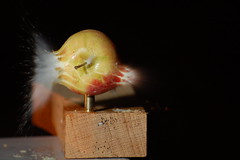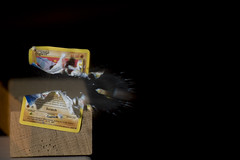Forums › Forums › Get Technical › Hardware › flash to shutter trigger adapter
- This topic has 12 replies, 4 voices, and was last updated 13 years, 9 months ago by
caradoc.
-
AuthorPosts
-
July 12, 2010 at 4:20 pm #1915
 orionidParticipant
orionidParticipantThe TL;DR background:
So, I’ve got one of these: http://makezine.com/04/strobe/ , and I’ve played around with it quite a bit for a lot of neat/fun photos.
Like:




But then, caradoc started posting daytime lightning shots with his arduino-driven IR trigger. And I started thinking: I could probably do something like that with analog (I’ll take transistors and op-amps over code most any day). So ideas started bouncing. Then someone posted a link to the camera axe and some other, high-dollar, bells and whistles controllers.The meat and potatoes:
Long story short, I built an adapter box so that I can connect the flash trigger to my camera to fire the shutter instead of a flash. Now I can do sound and break-beam activated shots in daylight, without having to hold open the shutter. I’m going to post the schematic for anyone interested as soon as I get it scanned (probably shortly after I get home, since the office scanner seems to be hosed currently). It all fits inside a radioshack small project box, and totalled about $15 in parts.
Then I went one step further. I took one of the IR photocells that I picked up for doing lightning (5 for $1 at a hamfest), soldered it to some wires opposite a 3.5mm stereo plug (red/tip and green/ring to one side, nuetral/sheath to the other). I plugged it in to the microphone input on the sound trigger, and it worked perfectly. The gain adjust for the mike even lets me gain adjust for ambient light. So, for a total investment of:
$65 bag-of-parts flash controller (no longer avail, just the $120 pre-assembled) and $15 in piece-parts, I now have a sound/ir/laser break-beam controller that will work with either a flash or the camera shutter. w00t./Now I need a thunderstorm to fully op-check.
July 12, 2010 at 5:10 pm #30879staplermofo
ParticipantGod I wish I could solder.
July 12, 2010 at 6:08 pm #30880caradoc
ParticipantHave you measured the delay from trigger-to-shutter?
My D80 is 80ms from the signal to the shutter, and the Arduino controller is 1ms from detect-to-signal, so “staccato” lightning that lasts less than 81 ms simply won’t show up in the frame – but I’ll get a photo of the landscape anyway.
There’s a decent table of trigger-to-shutter delays by make/model here.
July 12, 2010 at 6:16 pm #30881ravnostic
Participant8/100’s of a second? Dear God, man, how do you even measure such a thing? I’m still playing with marbles in the playground, and you’re accurately firing cannons (or nikkons) at villages not even on the horizon.)
July 12, 2010 at 6:22 pm #30882caradoc
Participant8/100’s of a second? Dear God, man, how do you even measure such a thing?
Personally, I don’t – which is why I linked to that table…
But I know a guy who’s actually done exactly that with an oscilloscope, laser, and light sensor – record the signal that triggers, and record the spike from the light sensor when it picks up the reflected light after the shutter opens.
July 12, 2010 at 6:26 pm #30883 orionidParticipant
orionidParticipantThe makezine controller is variable delay detect-to-signal from 1-20ms, but I didn’t know the trigger to shutter until I looked at that handy chart. The D90 is 65 ms, and Kestrana‘s D5000 is “untested.” I’m also estimating that between an op-amp, a transistor amplifier, and an opto-isolator, that my transistion box ads another 2-5 ms delay, so I’m looking at 68-90ms total, which should be fine fore the “monster strikes.”
July 12, 2010 at 7:13 pm #30884caradoc
ParticipantYes. A best-case 68ms would be good. 90ms would cut out a lot of strikes other than the “sky crawlers” that you can just watch moving across the clouds before they ground-strike.
July 12, 2010 at 7:29 pm #30885ravnostic
Participant{shoots steely at aggie, misses, hits tree.}
July 12, 2010 at 7:43 pm #30886 orionidParticipant
orionidParticipant8/100’s of a second? Dear God, man, how do you even measure such a thing?
It’s a process called time response testing. You can do it with a freeze-screen o-scope, digital data logger, or a high resolution strip chart recorder. It gets really fun when you have multiple things that are required to be within a certain number of miliseconds of each other (like time from change in reactor power to signal change on the instrument, time from signal change to operator alarm, time from signal change to each of several protection systems, and time for protection system to actually work, all while still measuring overall time from change in reactor power to full emergency shutdown (roughly 20 ms).
July 13, 2010 at 12:43 am #30887 orionidParticipant
orionidParticipantSchematic, as promised.
 July 13, 2010 at 2:41 am #30888
July 13, 2010 at 2:41 am #30888caradoc
ParticipantMight want to specify the camera for that schematic – for example, the Nikon D80 and the Nikon D300 invert the voltage across the tip and ring on standard Pocket Wizard-type shutter cables… it’s weird.
July 13, 2010 at 3:23 am #30889 orionidParticipant
orionidParticipantHmm… I see your point. I didn’t label it because I custom wired the 3.5mm (as it made sense to me) with a cable from a broken wired remote. I figured if I just showed it as common hi, then anyone who wanted to take the idea could adapt it as necessary.
July 13, 2010 at 3:29 am #30890caradoc
ParticipantI figured if I just showed it as common hi, then anyone who wanted to take the idea could adapt it as necessary.
That’s what got me into trouble with my own circuit – I made the bad assumption that using a Pocket Wizard shutter trigger cable would “standardize” things for me.
It didn’t.
-
AuthorPosts
- The topic ‘flash to shutter trigger adapter’ is closed to new replies.